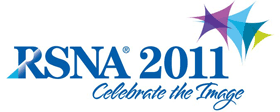
Abstract Archives of the RSNA, 2011
LL-CHS-MO3B
Concordance of Dual-Energy CT Iodine Perfusion Maps with Perfusion Parameter Maps of Pulmonary Perfusion MRI
Scientific Informal (Poster) Presentations
Presented on November 28, 2011
Presented as part of LL-CHS-MO: Chest
Jan Hansmann MD, Presenter: Nothing to Disclose
Christian Fink MD, Abstract Co-Author: Nothing to Disclose
Gerald Weisser, Abstract Co-Author: Institutional grant support, Apple Inc
Frank G. Zoellner, Abstract Co-Author: Nothing to Disclose
Stefan Oswald Schoenberg MD, PhD, Abstract Co-Author: Nothing to Disclose
Ulrike I. Attenberger MD, Abstract Co-Author: Nothing to Disclose
To investigate the concordance of dual energy CT (DECT) iodine perfusion maps with parameter maps derived from pulmonary perfusion MRI.
In this ongoing study 14 patients (10 men, 4 women, age range 20-81) with pulmonary perfusion defects detected on iodine perfusion maps of dual energy CTA additionally underwent time-resolved contrast-enhanced pulmonary MRA.
MRI data were semi-quantitatively analyzed by a pixel-by-pixel deconvolution analysis using an in-house developed software plugin, integrated into a standard DICOM viewer (OsiriX 3.7.1). Regional blood flow (BF), blood volume (BV) and mean transit time (MTT) were calculated in perfusion defects as well as in normal lung parenchyma. Perfusion parameters were correlated to mean attenuation values of DECT iodine maps. In addition, two readers rated the concordance of perfusion defects in a visual analysis using a 5-point scale (1 = no correlation, 5 = excellent).
In healthy pulmonary tissue the mean value for BF was 252 ± 362 ml/100 ml/min, the MTT was 7.3± 5.0 s and the BV was 33.3± 80.7 ml. In areas with restricted perfusion the BF was 68± 46.5 ml/100 ml/min, the MTT was 8.1± 4.1 s and the BV was 8.2 ±6.7 ml. A statistically significant difference could only be proven for the BF with a p-value of 0.03.
The mean attenuation value on DE-CTA iodine maps was 24.2±9.6 HU in normal parenchyma and 3.8±3.1 HU in perfusion defects (p<0.05) Correlation between DECT iodine maps and BF was strong (r=0.64, p<0.001), whereas correlation between MTT and BV values was less significant (MTT r=-0.3, p=0.07; BV r=0.4, p=0.006). In the visual analysis there was a good correlation between DECT iodine maps and the parameter maps of DCE-MRI (median score 3.5).
There is a high concordance of DECT iodine maps with perfusion parameter maps of DCE MRI. Therefore, DECT iodine maps might be used as a surrogate of pulmonary perfusion.
DECT iodine maps might be used as a surrogate of pulmonary perfusion.
Hansmann, J,
Fink, C,
Weisser, G,
Zoellner, F,
Schoenberg, S,
Attenberger, U,
Concordance of Dual-Energy CT Iodine Perfusion Maps with Perfusion Parameter Maps of Pulmonary Perfusion MRI. Radiological Society of North America 2011 Scientific Assembly and Annual Meeting, November 26 - December 2, 2011 ,Chicago IL.
http://archive.rsna.org/2011/11005091.html

